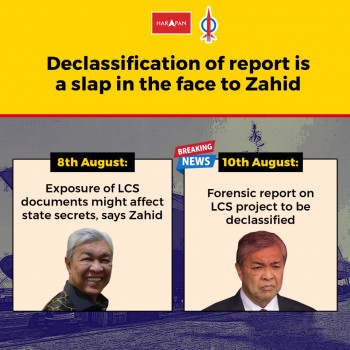By Zairil Khir Johari, MP for Bukit Bendera
 When the overly ambitious RM4.1 billion 1BestariNet project, which entails the installation of 4G high-speed broadband in all 10,000 across the country and a Virtual Learning Environment (VLE) e-learning system, was launched by the Ministry of Education (MOE) in December 2011, it was touted as a technological tool that would bridge the urban-rural divide.
When the overly ambitious RM4.1 billion 1BestariNet project, which entails the installation of 4G high-speed broadband in all 10,000 across the country and a Virtual Learning Environment (VLE) e-learning system, was launched by the Ministry of Education (MOE) in December 2011, it was touted as a technological tool that would bridge the urban-rural divide.
The rationale behind this claim was that by connecting rural schools to the Internet and allowing them access to the “cyber classroom” through the VLE, students in rural areas would no longer be handicapped by geography and would be able to tap onto the limitless repository of information in the digital world.
While such a proposition sounds great in theory, the unfortunate reality is quite the opposite. In fact, the Ministry’s approach of implementing a universal roll-out across all 10,000 schools in our country would actually widen the urban-rural gap.
The third series of the Auditor-General’s 2013 Report has pointed out that despite 8,807 schools already equipped with the VLE system, nationwide login statistics for the month of March 2014 were between 0.01 to 4.96 per cent. In fact, usage amongst students ranged from only 0.17 to 0.64 per cent, which is less than one per cent. This is an alarming figure, given that RM663 million has already spent over the last two and a half years.
Technological infrastructure a critical factor
Amongst the critical factors identified by the audit report for the low take-up of the e-learning software are technological inadequacies such as sluggish access to 1BestariNet, which hampers its usage during school hours, as well as a shortage of supplementary tools such as laptops and projectors in classrooms.
In fact, the audit report’s survey of 46 schools and 491 respondents showed that in most cases the broadband speeds averaged from 0.2Mbps to 3.62Mbps, which is much lower than the contractually promised 4Mbps to 20Mbps. As a result, not more than 30 to 40 users could log into the VLE at any one time.
There were also coverage problems, in which 58 per cent out of 501 schools sampled did not receive full coverage. To make up for this, schools were supplied with Yes Zoom devices that allowed limited coverage of up to 20 square metres and up to 20 users at a time. Even then, the audit report found that it was not enough as each school was only supplied with four such devices.
To make matters worse, the audit report found that the Internet connection and coverage provided by 1BestariNet was so bad that schools and teachers had to resort to subscribing to alternative Internet providers, thus “reducing work productivity and increasing financial costs.” Hence, it is no wonder that the VLE system is hardly used.
Stakeholder support and cooperation vital
Another critical factor identified by the audit report was the need for cooperation by all stakeholders. In particular, the successful implementation of the VLE system requires buy-in from the school management, the availability of technologically competent teachers, and support from parents at home.
These factors are corroborated by the example of SJKC Sam Tet in Ipoh, Perak, which recorded the highest VLE usage amongst all schools in the country. Figures from 1 January to 31 March 2014 showed as much as 20.6 per cent of students and 41.7 per cent of teachers accessed the VLE system everyday.
According to the Auditor-General’s Report, the relatively high usage of VLE in SJKC Sam Tet stemmed from the fact that their teachers had been fully exposed to the system, while the school management and Parent-Teacher Association displayed exception support by providing projectors in every classroom, hiring a special computer technician for the school, as well as bearing the cost of equipment repair.
In addition to that, the majority of students at the school also had computers and Internet access at home, which greatly facilitated assignments and VLE access outside the school.
Rural schools at a disadvantage
The case of SJKC Sam Tet is an important lesson. For the VLE to be successful, there needs to be strong technological infrastructure, well-trained and competent teachers, as well as full support from all stakeholders concerned.
Unfortunately, such a scenario is simply impossible to replicate across 10,000 schools, 500,000 teachers and 5.5 million students. This is especially so in the case of rural schools, which suffer inadequacies in every critical area. Not only are rural schools under-equipped in terms of laptops, projectors and computer labs, they would also suffer from bad Internet coverage. At the same time, it is unlikely that their teachers would be competently trained, while there is very little possibility of the students having computers and Internet access at home.
In other words, it is obvious that the full-scale deployment of 1BestariNet across all schools in the country would not only fail to achieve its objective of bridging the urban-rural divide, but in fact result in the opposite by widening the gap. This is due to the fact that well-supported urban schools would better positioned to reap the benefits of the cyber classroom while under-supported rural schools would be left further and further behind.



